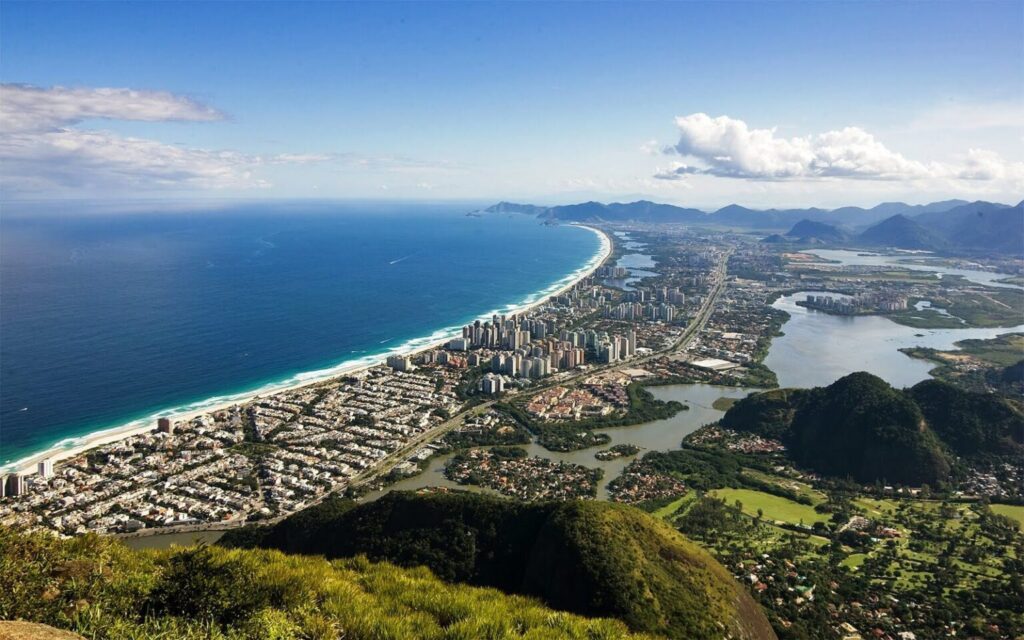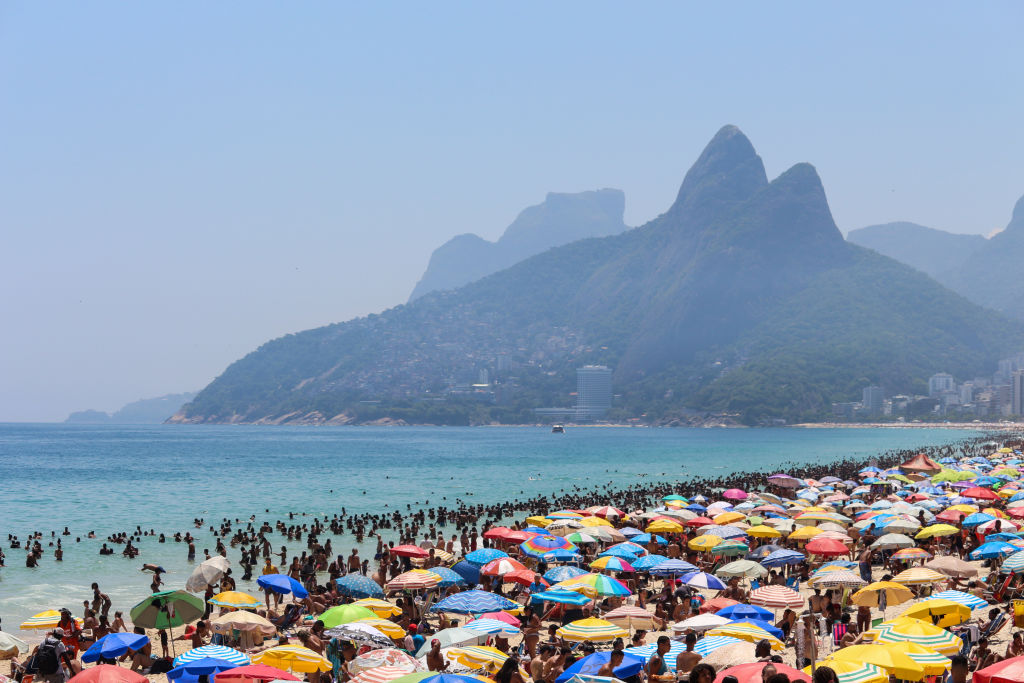Living in Rio de Janeiro – The Ultimate Guide in 2023
Living in Rio de Janeiro can sound like an attractive prospect for many reasons. Great climate, beach lifestyle, welcoming people, lower cost of living and abundance of nature are just some of the many factors that attract people here. That being said, moving somewhere new is never easy, and requires courage to make it happen, as well as some planning.

Table of Contents
Why Live in Rio de Janeiro?
Rio de Janeiro is world-famous cite and is often the gateway for most foreigners to Brazil due to its allure, Rio de Janeiro is the obvious choice for most people wanting to experiment living in Brazil – and for good reason. Here are a few things that tend to attract people to rio:
- Beach Lifestyle – Rio has lots of beaches with different vibes. Whether you’re into busy beaches, more secluded areas or want to surf you’ll find lots of options.
- Abundance of Nature – Has a huge national park within the city itself with lots of hikes, waterfalls and viewpoints over the city.
- Outgoing & Friendly People – Locals are chatty, receptive and generally easy to make friends with.
- Lower Cost of Living – Cost of living is noticeably cheaper than parts of Western Europe and North America
- Higher Sense of Freedom – There’s a sense of freedom you get living here that you don’t get in many western countries. It’s difficult to explain this without spending some time here.
Must Know Things Before Moving to Rio de Janeiro
- Lower Levels of English – As in many other places in Brazil, English isn’t that widely spoken. You’ll certainly find people who do speak English but you’ll seriously struggle to get by day to day and integrate yourself into the culture without a solid knowledge of portuguese.
- Cost of Living – Despite being much cheaper than most North American and Western European Cities, Rio isn’t exactly a bargain, and you should expect to pay at least 50% more than you would in 2nd tier Brazilian Cities. Also, as in the rest of Brazil, things such as clothes, imported items such as electronics can be noticeably more expensive than other countries. Gyms and Supermarkets aren’t cheap.
- More Foreigners than other Brazilian Cities – Due its appeal and accessibility , there’s no surprise that Rio de Janeiro has by far the highest number of foreigners in Brazil, which can be a pro or con depending on the way you look at it. It’s good in the sense that you’ll find it easier to meet other expats, but might not be ideal if you’re looking to immerse yourself fully in Brazilian Culture and want to get away from other expats.
- Safety – Rio has a reputation for being a dangerous city, and has this for good reason. That being said, this massively depends on the neighborhood you’re in, and these fears tend to be exaggerated. For more information on this, keep on reading this post.
- Work Opportunities Difficult to Come By – It can be pretty difficult to find decent work opportunities as foreigners, mainly due to the fact that jobs tend to pay less here than in North America and Europe, and Brazilian Law makes it difficult to hire foreigners. Also, the language is obviously a big issue, so with this in mind, it’s recommended to work remotely.
Best Areas to Live

The vast majority of foreigners decide to live in Zona Sul, with smaller numbers in Barra da Tijuca and centro. The rest of the city is usually avoided by foreigners due to its reputation for danger, lack of beaches and noticeable attractions. With this in mind, we’ll focus on Zona Sul and Barra:
Copacabana – An obvious choice for many foreigners, Copacabana is a draw due to its location, proximity to the beach, as well as reasonable prices compared to areas such as Ipanema and Leblon. That being said, the area does have a slightly run down and tacky feel, and can be seedy in certain areas. But overall it’s a solid choice.
Leblon – A very popular choice amongst foreigners, Leblon is a great neighborhood located nicely. With a beautiful beach, nightlife options, many leafy areas and lots of attractions/things to do within walking distance, Leblon is often considered the best neighborhood to live in Rio and is a very pleasant area to live in. That being said, prices can be very high here and value for money isn’t great. Eating options also tend to be poor value for money compared to other areas.
Ipanema – With a similar vibe to Leblon, Ipanema is also a great area to live in and slightly cheaper than Leblon. Lots of attractions within walking distance, a great beach and good eating options although not as many nightlife options as Leblon. Overall a great neighborhood to live in.
Botafogo/Flamengo – The most bohemian neighborhood in Zona Sul, Botafogo is a great area to live in with a more ‘hipster’ feel. Has food options and a good nightlife scene, although the beach leaves a lot to be desired compared to other areas in Zona Sul. Flamengo, next to Botafogo, is a more residential neighborhood but has a nicer beach and has lots of sporting activities.

Centro/Santa Teresa/Lapa – the central areas of Rio can be sketchy and aren’t exactly the most visually appealing places either, so they wouldn’t be my top choices for places to live. That being said, the area is currently going under a rejuvenation phase with lots of new apartment buildings popping up, and this part of town is noticeably cheaper than Zona Sul. Santa Teresa is an older area near Centro, with lots of picturesque colonial houses which offers a different feel to the hustle and bustle of other areas of Rio.
Barra da Tijuca/Recreio
Barra da Tijuca is huge, and offers a different lifestyle to Zona Sul, with most people living in large condominiums that have pools, gyms, sporting activities and things to do. You’ll also get better value for money when it comes to apartments here than in Zona Sul. The drawback of living in Barra is that there aren’t many things within walking distance and it’s recommended to have a car even for things such as getting groceries. On the plus side, this area arguably has the nicest beaches in Rio and is also good for surfing. On the other side of Barra is Recreio, a residential beachside neighborhood which has more of a small town and surfer vibe and offers cheaper accommodation options. The drawback here is the distance from Zona Sul meaning that getting around the city can be more expensive.

Meeting People when Living in Rio de Janeiro
Meeting people when moving to a new city can be daunting, and is especially difficult when you don’t have a solid grasp on the language, aren’t acquainted with the culture and don’t know anyone before arrival. That being said, due to the extrovert tendencies and openness of the people, it can be easier than in other countries if you have the right mindset.
A good place to start is meeting fellow expats, for which there are different whatsapp groups dedicated to different things such as going out at night, activities and meetups (message us for more details). There are also different meetup events in the city for people who have just arrived and looking to meet new people.
In terms of locals, Cariocas are friendly people and are often welcoming of foreigners meaning that you shouldn’t have too many issues making local friends if you put the effort in. That being said, as in any other city, a lot of them have their own established social groups and aren’t necessarily actively looking to make new friends so don’t be disheartened if not everyone is open to becoming friends. If you’re curious about finding out what are the best ways to meet new people in Rio, don’t hesitate to reach out and we’ll give you a few personal tips.
There’s no beating around the bush – learning Portuguese is an absolute must if you’re planning on living in Rio de Janeiro, and you’ll be severely limited if you expect people to speak English to you. Don’t get me wrong, you will meet a decent amount of people who speak English and many of these will be eager to get some practice in with you, but this is probably only 5-10% of the population. What this means is that in day to day interactions, business transactions and running errands, Portuguese is absolutely necessary so learning the language should be at the top of your priority list.
How important is Learning Portuguese when Living in Rio de Janeiro?
There’s a direct correlation between how enjoyable and rewarding your experience will be living in Brazil with how much effort you make with the language, and luckily, learning Portuguese isn’t as hard as you think and doesn’t require you to spend all day in a classroom.
In fact, with 30 mins a day you can make significant progress with the right learning methods, mindset and attitude. If you’re interested in learning more about our language learning methods at Smooth Move Brazil, please check out our Brazilian Portuguese Page.
Dating in Rio de Janeiro
One of the most frequently asked questions I get about living in Rio de Janeiro is about the dating scene, which is vastly different to what you’ll find in countries such as the USA and UK. As a man, you’ll be expected to be more direct with your intentions here, meaning that not being afraid to overtly show your interest works better than the ‘playing hard to get’ mentally. However, with this in mind, male gringos often have the reputation as ‘sex tourists’ so it’s important to be socially calibrated, completely respectful and know when to back off. As a woman, you’ll find the local men direct and forward, which might be different to what you’re used to back home.
Weather/Climate in Rio de Janeiro
The climate in Rio de Janeiro is one of its main draws, and you can expect warm weather all year round, with anything below 20 degrees celsius being considered cold! The seasons are as follows:
Summer – Late December to March – this is the busiest and liveliest time of year and you’ll find the beaches rammed most days. The weather can be very hot and muggy which can be uncomfortable, but on the plus side the days are longer meaning that you can enjoy the beach in the evenings. On the hottest days, expect temperatures with a heat sensation of 40-45 degrees celsius (due to the humidity). Rain is abundant this time of year, but most of these are passing showers, and there are also plenty of sunshine hours.
This time of year is also when lots of Brazilians take holidays meaning that prices are higher, big events occur such as New Year and Carnival, and is also the time of year that receives most foreigners.

Autumn – April to Mid-June – The weather is glorious during this time of year with mainly sunny days and cooler nights and the crowds thin out meaning that the beach has more of a laid back feel. Usually the days are sunny and there is little rainfall this time of year.
Winter – Mid- June – September – With average daily highs of 25 degrees celsius and night temperatures of 18 degrees, Rio’s Winter is better than many European countries! Usually it’s sunny this time of year although when it gets overcast or rainy you’ll find that there are not many people out and about. When it’s sunny, the temperatures are still good for the beach although it starts to get cool around 3pm. The city has a more relaxed and chilled out feel during this time of year and is quieter.
Spring – September to Mid-December – This time of year sees pleasant temperatures at day and at night but can experience a fair amount of overcast and rainy days compared to other periods of the year. That being said, there are a decent amount of sunny days and overall this is a pleasant time of year with fewer tourists and lower prices.

Rio on a Cloudy and cooler Day
Safety and Security in Rio de Janeiro
Safety is a serious concern when living in Rio de Janeiro and certain precautions need to be taken when living here. That being said, these fears are often greatly exaggerated and most people who live here experience few problems.
Many of the crimes occur in the Favelas, and in certain parts of Zona Norte and inland areas of Zona Oeste. These areas are best avoided, as well as areas on the outskirts such as Duque de Caxias and Sao Goncalo.
Avoiding going into Favelas will reduce the risk of danger significantly, although there are some that do receive tourists and are generally ok to visit such as Vidigal.
Zona Sul, where most of the foreigners live, is generally safe, but there’s always the risk of being robbed, so it’s important to always keep your wits about you without getting paranoid. One of the most common annoyances is teenagers from the favelas running around in groups snatching phones from people walking along the beachfront or other areas so also be careful when walking around with your phone. Beggars can be a common annoyance in areas such as Leblon and Ipanema, and although they can be unnecessarily aggressive, they’re usually harmless. The best way to deal with these is to be firm but polite.
Overall, Rio de Janeiro has a big problem with violence but this is limited to certain areas such as the favelas and although you have to have your wits about you, this shouldn’t deter from living here.
Cost of Living in Rio de Janeiro
Despite common thinking, living in Brazil isn’t that cheap, especially when compared to other Latin American Countries such as Peru, Colombia or Mexico. However, it’s still noticeably cheaper than the UK, Australia or the USA, and you’ll get better value for money here. Here’s a rough guideline of what you can expect:
Rent – This really depends on where you’re living, with Leblon being the most expensive area (you can expect to pay around $1200-1800 per month for a 1 bedroom apartment.) Ipanema is slightly cheaper, and Copacabana can be noticeably cheaper with prices of around $800-1200. Botafogo also offers good value for money as well as certain areas of Barra da Tijuca. As expected, renting a place on AirBnb is more expensive, so it’s worth negotiating with the owner or looking for longer term rentals if you’re wanting to stay long term.
In terms of other expenses, supermarkets are similarly priced to Europe, but fresh produce is cheaper, whilst frozen goods are more expensive. Anything imported tends to be overpriced due to the taxes applied. Eating out is around 50% of the cost of Europe.
Job Opportunities
Finding a decent job whilst living in Rio de Janeiro without a visa is a tough deal, and will be significantly harder if you don’t speak Portuguese fluently. Due to Brazilian Protectionist Laws, it’s tough for companies to hire foreigners who don’t already have residency and most companies aren’t willing to go through the bureaucratic process of sponsoring a foreigner. However, it is still possible, and the larger the company, the better position they generally are to hire you. With this in mind, due to bureaucracy, long working hours and lower salaries, your best bet is to find a job overseas that allows you to work remotely.
Nightlife
Despite not being as good as Sao Paulo, Rio has a decent nightlife scene with these being the best areas:
Leblon- In recent years, the street ‘Dias Ferreira’ has become a popular spot with lots of bars.. Whether you’re looking for a lively bar where you interact with people, or like the idea of sitting at a table chatting with friends, you’ll find both options here. This area tends to be popular with tourists from other areas of Brazil and foreigners and has a more ‘playboy’ vibe. No clubs, just bars.
Gavea – Baixo Gavea is a spot in Gavea and only a 5 minute drive from Dias Ferreira. Lots of bars around and people stood drinking on the street as well as a couple of rooftop bars. Vibe is a bit more cliquey than Dias Ferreira so it can be more difficult to meet new people. Some good clubs nearby are Bosque, EXC and Dumont.
Barra da Tijuca – Olegario Maciel is another street lined with lively bars in Barra da Tijuca, and has a different vibe to Gavea and Leblon and is worth checking out Thursday-Sunday. There are few clubs nearby such as Vitrinni Lounge and All-in.
Botafogo – With a different vibe to the above, Botafogo has a similar set up but with a more hipster vibe around Alvaro Ramos Street, and is definitely worth checking out on Fridays and Saturdays. Voluntarios da Patria has some bars as well, although the area isn’t quite as nice. As well as the hipster scene. There are a few bars with more of a party vibe like Canastra and Bukowski which attract a similar crowd to Leblon.
Lapa/Centro – Lapa is the classic gringo spot and although it’s fun to go to once or twice, it’s a pretty seedy area and doesn’t always attract the best people. Praca da harmonia in centro has become a popular spot amongst the alternative scene.
Conclusion
As you can see, there are lots of different factors to take into account when living in Rio de Janeiro, and hopefully this guide has been of use. If you have any more questions feel free to reach out and we’ll do our best to reply, and if after reading this you like the idea of living in rio de janeiro, get in touch and we can help you set up an action plan to make the move a reality.

